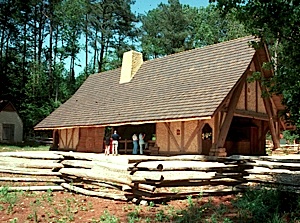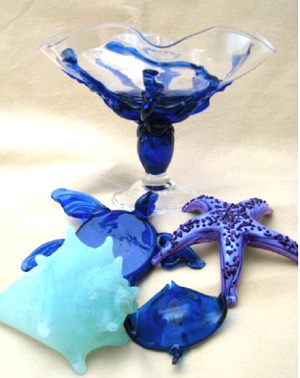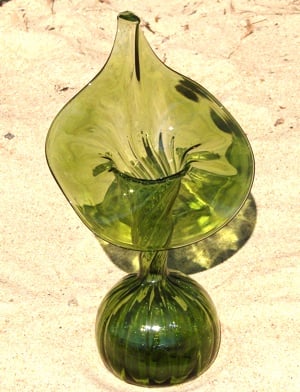Visiting historic Jamestown, part of Colonial National Historical Park, is truly a unique experience. Park visitors take a step back in time and see firsthand what life was like for the colonials, the challenges they faced and the will that it took for them to survive.
The Jamestown Glasshouse plays a major role in the interpretation of the site, providing visitors with an insight into the talent and skill essential for glassblowing.
Little is known about the success of this first attempt at glassmaking in America. A letter from William Starchey, secretary for the Virginia Company of London written in 1610 from Jamestown, stated that the glasshouse was "a goodly house ... with all offices and furnaces thereto belonging."

The glasshouse at historic Jamestown. NPS photo.
A second attempt at glass manufacturing was made in 1622, when Italian artisans were sent to America with the same mission. According to all historical accounts, this second attempt was unsuccessful.
In 1948, archaeologists excavating ruins in Jamestown discovered the ruins of colonial glassmaking furnaces. In connection with the 350th anniversary of the Jamestown settlement, the Jamestown Glass Foundation, headed by Carl Gustkey, president of Imperial Glass Company of Newark, Ohio, was compelled to demonstrate 17th-century glassmaking techniques to visitors. Extensive research was compiled through a grant from Eastern National, Colonial NHP’s cooperating association, and by 1957 the colonial furnaces were reconstructed and opened to visitors
The Jamestown Foundation operated the glass furnace at Jamestown for two years, but could not make the operation profitable. As much as park visitors were fascinated by the colonial glassmaking process, and the glassmaking process was an excellent interpretive demonstration, the Jamestown Foundation decided to close down the operation.
National Park Service Director Conrad L. Wirth was eager to keep the Jamestown Glasshouse operating, and prevailed upon Eastern National to consider taking over the operation on a trial basis. The Board of Directors of Eastern National were concerned about the prospect, but eventually agreed to invest capital into the operation in an attempt to make it sustainable.
With the resourcefulness of Colonial NHP’s Superintendent Stanley Abbott, operating costs were cut significantly and the glassmaking operations were streamlined. By 1961, the Glasshouse reported its first profit, and the colonial glassmaking demonstrations at Jamestown continue to be a major attraction for visitors of the park.

More contemporary artworks are also produced at Jamestown. Eastern National photo.
In September of 2003, the Jamestown Glasshouse was again in peril. As Hurricane Isabel raged up the coast of North Carolina and slammed into Virginia, the Jamestown Glasshouse was destroyed by storm surge and high winds. A temporary sales site was set up in the parking lot and glassblowing was halted for nine months. The Jamestown Glasshouse was rebuilt by Eastern National and finally reopened to visitors in June of 2004.
Today, the local artisans at Jamestown Glasshouse handcraft reproductions of colonial and contemporary glassware which are available for sale at the site or on eParks.com. The artisans also produce a number of limited edition art glass pieces, hand blown and crafted, such as the limited edition 2012 John Greene Vessel. This stunning piece is an adaptation based on a late 17th century design by Allesio Morelli, found in the drawings of John Greene of the London Glass Seller's Company.
The contemporary glass series produced by the Jamestown Glasshouse showcase the vision and talent of these skilled artisans. The Seashore Glass series, which was first produced in 2009, became very popular and featured exquisite pieces such as the Octopus Bowl and Conch Shell.

Jack-in-the-Pulpit Vase. Eastern National photo.
If you would like to learn more about the Jamestown Glasshouse, you can view this short YouTube video where Eric Schneider, master glassblower, demonstrates his skill and gives a brief overview of the Glasshouse.
Visit the Jamestown Glasshouse’s website or the National Park Service’s website for Colonial National Historical Park for visitor information, or contact the Glasshouse directly at (757) 229-2437.


 Support Essential Coverage of Essential Places
Support Essential Coverage of Essential Places







Comments
I saw one of these on Shop Good will site, they had it listed as a Murano glass vase * it has 2 little cheep green candle holders with it, iI sent them a msg on the item Correcting them the it was JamesTown Glass "Jack-in-the-Pulpit Vase" & they corrected the listing :)!! I want to buy it the auction is still open till 8pm tonight. It has no bids yet, starting is $8.00 i Wany it!! But the shipping is darn near $20.00 :( I'll keep looking for stuff from your collection for my collection that i can aford. Soon i hope soo Beautiful!! ~ jacci